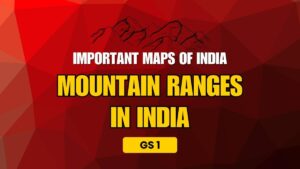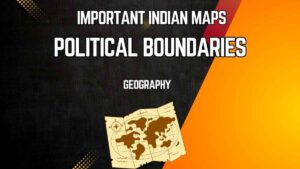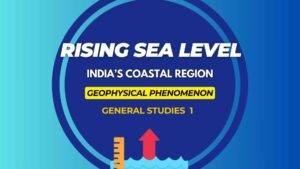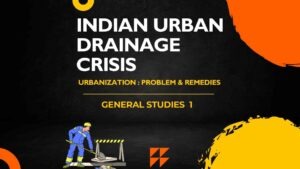Sea Level Rise at India's Coastal Region
Sea Level Rise at India's Coastal Region
🧭 Context
The World Meteorological Organization (WMO) released its State of the Climate in Asia 2024 Report, highlighting alarming climate trends, especially in India and South Asia. The report reveals faster-than-global-average sea level rise along India’s coast, heatwaves, glacial retreat, and increasing extreme weather events.
🇮🇳 Key Climate Trends in India
🌊 Sea Level Rise (SLR)
Arabian Sea: Rising at 3.9 ± 0.4 mm/year
Bay of Bengal: Rising at 4.0 ± 0.4 mm/year
Global Average: ~3.4 mm/year
Implication: Coastal submergence risk in low-lying areas within 50 km of India’s coast (e.g., Mumbai, Chennai, Kolkata).
🏝️ Coastal Vulnerability
Impact: Threat to livelihoods (fisherfolk, farmers), tourism, and infrastructure.
Risk of Climate-Induced Migration from eastern and western coastal belts.
🏔️ Glacial Retreat
23 out of 24 glaciers in Central Himalayas losing mass.
Increased GLOF (Glacial Lake Outburst Flood) events → downstream flooding risk.
Risk to hydropower plants, roads, and mountain settlements.
🌡️ Heatwaves
2024: Over 450 deaths across multiple states.
Prolonged and extreme heat events increasing due to urban heat island effect and climate change.
⚡ Lightning Strikes
1300 deaths in 2024;
July 10 event: 72 deaths across five states → shows growing intensity of convective weather events.
🌏 Key Climate Trends in Asia
Asia heating at twice the global average.
2024: Second warmest year in Asia’s history.
Frequent disasters: Landslides, floods, and heatwaves.
Kerala’s Wayanad: 350+ deaths after 500 mm rainfall in 48 hours → intense cloudbursts and extreme precipitation.
Glacier melt in Himalayas and Tian Shan → more GLOFs, threat to regional water security.
🌡️ Causes of Sea Level Rise
| Factor | Explanation |
|---|---|
| Thermal Expansion | Warming oceans expand in volume |
| Melting of Ice Sheets | Greenland, Antarctica, and global glaciers |
| Greenhouse Gas Emissions | CO₂ & other GHGs drive warming |
| Ocean Current Variability | Regional circulation shifts redistribute ocean heat |
🚨 Consequences
For India:
Coastal Erosion: Retreat of shorelines along both coasts.
Loss of Livelihoods: Impacts on fishing, agriculture, and coastal tourism.
Urban Infrastructure Risk: Ports, industries, homes at threat.
Climate Migration: Rising displacement → internal migration pressures.
For Asia:
Island Nations: Maldives & Pacific islands face existential threats.
Urban Heat Stress: Increased morbidity in cities.
Agricultural Disruption: Lower yields due to erratic rainfall & heat.
Health Impacts: Rise in heatstroke, malaria, dengue, etc.
📍 Case Study: Nepal
Glacier loss in Central Himalayas → Rising GLOFs.
Threat to hydropower, transport, and mountain communities.
Reflects Himalayan fragility and transboundary climate risks.
✅ Recommended Measures
| Strategy | Details |
|---|---|
| Coastal Zone Management | Build climate-resilient infrastructure, restore mangroves, enforce CRZ norms |
| Emission Reduction | Fast-track NDC targets, promote net-zero path |
| Early Warning Systems | Invest in forecasting, IMD capabilities, disaster response |
| International Cooperation | Climate finance, technology transfer under UNFCCC, Loss & Damage Fund |
| Community Capacity Building | Train local communities in adaptive farming, flood resilience, heat mitigation |
📝 Value Addition for Mains (GS3 – Environment & Disaster Management)
Keywords to Use:
Climate Resilience
Climate-induced Migration
Urban Heat Island
Glacial Lake Outburst Flood (GLOF)
Nature-based Solutions
Thermal Expansion
Blue Economy
📌 Prelims Facts for Quick Revision
Arabian Sea SLR: 3.9 mm/year
Bay of Bengal SLR: 4.0 mm/year
Global Average SLR: 3.4 mm/year
Heatwave Deaths (India, 2024): 450+
Lightning Deaths (India, 2024): 1300
WMO HQ: Geneva, Switzerland
Nepal’s GLOF Threat: Linked to Central Himalayan glacier loss
Mains-Based Questions on Sea Level Rise at India's Coastal Region
Q1. “The Indian subcontinent is increasingly vulnerable to both coastal and glacial climate risks.” Examine in the light of the WMO’s State of the Climate in Asia 2024 report.
Answer Framework:
Introduction:
Quote the WMO 2024 report briefly: India facing above-average sea level rise and glacial melt.
Define what “coastal and glacial risks” mean.
Body:
Coastal Risks:
Faster SLR in Arabian Sea (3.9 mm/yr) and Bay of Bengal (4.0 mm/yr).
Risks to cities like Mumbai, Chennai, Kolkata.
Livelihood loss (fisherfolk, tourism), infrastructure damage, migration.
Glacial Risks:
23/24 glaciers in Central Himalayas retreating.
Rise in GLOFs → downstream flooding in Himalayan states.
Impacts on hydropower, mountain communities, and agriculture.
Vulnerable Populations:
Poor urban dwellers in coastal slums.
Indigenous Himalayan populations.
Conclusion:
India must integrate coastal regulation with Himalayan environmental policies.
Community participation and scientific monitoring should be enhanced.
Q2. Discuss the multi-dimensional impact of sea level rise on India, with reference to the WMO’s 2024 report. Suggest measures to build coastal resilience.
Answer Framework:
Introduction:
Reference WMO’s report: India’s sea level rise is faster than global average.
Sea level rise = slow-onset but high-impact disaster.
Body:
Impacts of SLR:
Erosion: Loss of land along coasts (Odisha, Kerala).
Livelihood: Loss of fishing/agriculture income.
Infrastructure Damage: Ports, refineries, SEZs at risk.
Migration: Influx into urban centers → urban pressure.
Salinization: Agricultural land & groundwater affected.
Coastal Resilience Measures:
Mangrove restoration (e.g., Sundarbans).
Coastal Regulation Zones (CRZ) – strict enforcement.
Early warning systems, hazard zoning.
Sustainable tourism & development policies.
Conclusion:
Coastal resilience must combine ecological restoration, technological solutions, and community participation.
Q3. “Glacial retreat is no longer just an environmental concern, but a developmental challenge for India.” Elucidate.
Answer Framework:
Introduction:
Highlight WMO 2024: Rapid Himalayan glacier retreat.
Link it to water security, energy, and development.
Body:
Environmental Aspects:
Loss of glacier mass → GLOFs.
Biodiversity impact in fragile Himalayan ecosystems.
Developmental Challenges:
Hydropower at risk (e.g., Tapovan disaster, 2021).
Threats to transport (roads, bridges).
Irrigation systems fed by glacial rivers affected.
GLOF-induced floods damaging villages/towns.
Policy & Planning Concerns:
Inadequate monitoring.
Lack of transboundary cooperation on glacier studies.
Poor early warning systems.
Conclusion:
Glacial management must become a development priority, not just a climate concern.
Q4. Heatwaves and lightning are becoming silent killers in India’s climate discourse. Analyse their growing threat and suggest mitigation strategies.
Answer Framework:
Introduction:
Mention 450+ deaths due to heatwaves, 1300 due to lightning in 2024 (WMO report).
Body:
Growing Threat:
Urban heat islands amplifying heatwaves.
Lightning events increasing due to convection & moisture variability.
Poor housing and lack of awareness in rural areas.
Impact on elderly, outdoor workers.
Impacts:
Health: Stroke, dehydration, vector diseases.
Economy: Loss of productivity, damage to crops/electric infrastructure.
Inequity: Marginalized communities hit hardest.
Mitigation Strategies:
City-level Heat Action Plans (e.g., Ahmedabad model).
Early warning systems for lightning (e.g., DAMINI app).
Passive cooling architecture in rural housing.
Tree cover and green spaces.
Conclusion:
Silent climate risks must be integrated into disaster planning and national climate missions.
🖋️ Essay Paper
Q5. “The geography of climate risk is shifting fast – from ice to ocean, and cities to villages.” Critically analyse in the context of Asia’s climate challenges.
Answer Framework:
Introduction:
Reflect on how WMO’s report paints a dynamic picture of climate risk across ecosystems.
Body:
From Glaciers:
Melting glaciers causing floods → mountain insecurity.
To Oceans:
SLR displacing millions, affecting mega cities and islands.
From Urban:
Cities face heatwaves, infrastructure burden.
To Rural:
Farmers face erratic rainfall, drought, lightning strikes.
Conclusion:
Climate is not just a future problem; it’s a here-and-now geography of inequity, requiring resilient and decentralized solutions.
Prelims Questions based on Sea Level Rise at India's Coastal Region
-
Important Mountain Ranges in India
When preparing for UPSC, mapping is crucial. The exam often... -
Important Indian Maps – Political Boundaries
Important Indian Maps - Political Boundaries of India comprises of... -
Servants of India Society – Important UPSC Notes
Servants of India Society was founded by Gopal Krishna Gokhale.... -
Sea Level Rise at India’s Coastal Region – Important UPSC Notes
The World Meteorological Organization (WMO) released its State of the... -
Indian Urban Drainage Crisis – Important UPSC Notes
The post "Indian Urban Drainage Crisis" talks about the issue... -
Jayaprakash Narayan Important UPSC Notes
Commemorating the 51st anniversary of Jayaprakash Narayan’s (JP) “Total Revolution”... -
Sant Kabir Das – UPSC Notes
Sant Kabir Das Jayanti was celebrated on June 11, 2025,...








